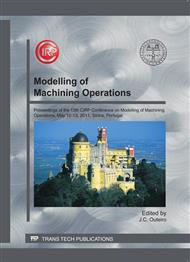[1]
C. Bonnet: Compréhension des mécanismes de coupe lors du perçage à sec de l'empilage Ti6Al4V/Composite fibre de carbone, Thèse de doctorat, Arts et Métiers ParisTech, centre de cluny, (2010).
Google Scholar
[2]
V. Chandrasekharan, S.G. Kapoor and DeVor R.E.: A mechanistic approach to predicting the cutting forces in drilling: with application to fiber-reinforced composite materials, Journal of engineering for industry, Transactions ASME, Vol. 117, pp.559-570, (1995).
DOI: 10.1115/1.2803534
Google Scholar
[3]
Y. Gong, C.L. Kornel and F. Ehmann: Dynamics of Initial Penetration in Drilling: Part 1-Mechanistic Model for Dynamic Forces: Journal of Manufacturing Science and Engineering, Transactions of the ASME Vol. 127 (MAY 2005), pp.280-288.
DOI: 10.1115/1.1852569
Google Scholar
[4]
H. Ho-cheng and C.C. Tsao: The path towards delamination-free drilling of composite materials: Journal of materials processing technology Vol. 167 (2005), pp.251-264.
DOI: 10.1016/j.jmatprotec.2005.06.039
Google Scholar
[5]
E. Kimivaa in: Cutting force in wood working, Helsinki (1950).
Google Scholar
[6]
S. C. Lin and I.K. Chen: drilling carbon fiber-reinforced composite material at high speed: Wear Vol. 194 (1996), pp.156-162.
DOI: 10.1016/0043-1648(95)06831-7
Google Scholar
[7]
W.M. McKenzie in: Fundamental aspects of the wood cutting process: Forest Products Journal 10 (1960), pp.447-456.
Google Scholar
[8]
A. Mondelin, B. Furet and J. Rech: Characterisation of friction properties between a laminated carbon fibers reinforced polymer and a monocrystalline diamond under dry or lubricated conditions: Tribology international, Vol. 43-9 (2010).
DOI: 10.1016/j.triboint.2010.03.015
Google Scholar
[9]
A. Thangaraj and M. Langenstein: An Investigation Into the Relationships Between Hole Quality and Drilling Forces: Proceedings of Manufacturing International, Part 4: Advances in Materials and Automation Vol. 4 (1990), pp.149-157.
Google Scholar
[10]
A. Velayudham and R. Krishnamurthy: Effect of point geometry and their influence on thrust and delamination in drilling of polymeric composites: Journal of Materials Processing Technology Vol. 185 (2007), p.204–209.
DOI: 10.1016/j.jmatprotec.2006.03.146
Google Scholar
[11]
W. Koenig, C. Wulf, P. Grass and H. Willerscheid: Machining of fiber reinforced plastics: Annals of the CIRP Vol. 34-2 (1985), p.538–548.
DOI: 10.1016/s0007-8506(07)60186-3
Google Scholar
[12]
R. Zitoune, F. Collombet, F. Lachaud and R. Piquet: Experiment-calculation comparison of the cutting conditions representative of the long fiber composite drilling phase: Composites Science and Technology Vol. 65 (2005), p.455–466.
DOI: 10.1016/j.compscitech.2004.09.028
Google Scholar
[13]
http: /news. thomasnet. com/fullstory: Drill-is-designed-for-aerospace-CFRP-cutting applications, June 25 (2007), Kennametal Inc. Latrobe, PA.
Google Scholar
[14]
http: /www. sae. org/mags/AEM/5907: Kannemetal makes the cut on composites, 19 Février (2009).
Google Scholar
[15]
M. Denford in: Drill Delates Delamination in CFRP, Modern Machine Shop, Editor, MMS Online, Gardner Publications, Inc. (2010).
Google Scholar
[16]
Modern Machine Shop in: English university acquires laser for cutting carbon fiber composites: New item from Composites world, MMS Online, Gardner Publications, Inc. (2010).
Google Scholar


